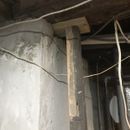Hvac door in tricky spot, do I need a jack post?
Hope everyone is doing well, so I have a tricky spot to put a door to my hvac in basement and wanted to see an opinion. About 3 years ago a carpenter placed a double 2×4 under a joist he said I needed extra support for (picture attached). The wood is at an angle and away from wall. I want to place a narrow prehung door here and have about 37inches to work with from foundation wall to a main hvac duct. Could I tapcon a 2×4 into the foundation wall and under the joist and then continue to build a doorway. Or do I need to add a steel beam in there as well? The joist is sitting on concrete so I’m confused what the wood is for. Hopefully to picture makes more sense of what I’m trying to do.
GBA Detail Library
A collection of one thousand construction details organized by climate and house part











Replies
I can't tell from your description where the joist is in relation to the door -- perpendicular, parallel? --- but I think you could frame the wall around the door as a bearing wall and rest the joist on it. Normally the rough opening is 2" more than the door size, and there's a double 2x4 on each side of the opening, so you need 8" more than the door size. If you have 37" you could put a 28" door in.
If that joist itself is structurally sound (no big splits, etc, in the end over the masonry wall), you could probably put the jack post directly against the foundation wall to clear up some space if you wanted to.
Note that with any structural issue, if you have ANY DOUBTS at all, have someone qualified come out to look at the site.
Bill
The joist is in good condition, I was hoping making a strong door frame would provide enough extra support to avoid adding a jack post against the foundation wall. The joist will be sitting directly on the door frame I guess that would be parallel. Double 2x4 on each side with a header of at least double 2x6 sounds like enough support. I’m kind of confused on what makes a wall a bearing wall compared to a regular partition wall. Is it the amount of wood? Also on the side that is directly against the foundation wall do I need a sill plate or could the 2x4 stand up directly against the foundation wall? Do I need to temporarily support joist at any point or can I slide a 2x4 directly in front of old post?
The thing that makes a wall "load bearing" is if it's holding something else other than itself up. Two examples to clarify:
1- NON-load bearing partition wall: This would be a studwall to wall off a room, any may be parallel to the joists above, or perpindicular to the joists somewhere along their span but NOT required to support the span. A wall like this isn't carrying load from the floor above, and can be safely removed.
2- LOAD-bearing: If you see the ENDS of joists above a wall, chances are that the wall is load bearing. This is especially common with walls under the centerline (ridge) of a roof. In this case, the ends of the joists are resting on the top of the load bearing wall, so that wall is supporting the load and transfering forces down to the floor below (and ultimately to the foundation).
These are basic examples, and it can get much more complex depending on the structure. The general rule though is that forces and transferred down to the foundation throughout the structure of the home -- think of it as a bunch of vertical arrows pointing down. Anywhere one of these arrows is, something needs to support the "bottom" of that arrow. You don't want load from above transferred to the middle of a floor that has no support directly underneath, for example. You want to keep those arrows from the roof pointing STRAIGHT down as much as possible, going through structure and not empty space.
Hopefully that makes sense. This is one of those things where a drawing is really helpful, or even better is to walk through a newly framed house where you can still see all the connections between structural elements.
Bill
It is hard to tell from one photo but what I see looks very bad and looks well beyond DIY repairs. My guess it will likely cost many thousands of dollars to remove and replace the failing concrete under the large beam that is likely supporting much of your house.
Is the wood rotting at the end of the green arrows?
How accurate is my guess that the beam is about 9 x 4.5?
If you put a level on the side of the wooden post would it be plum or not? It has been my experience that angled posts do not support much weight as they tent to bend and slide out of place under a load.
Walta
The joist is sitting on the main support beam. So it has 2 points of contact the center beam in middle and foundation wall on the other side. The concrete repair was done after the makeshift beam. It is a rumble foundation with concrete parging. The beam is sitting on stone, it was repointed, I think that’s what you call that repair. I could slide a post in there for additional support and still have room to build a smaller doorway. I could be wrong but worse case scenario if wall fails wouldn’t the floor above sag on one side and it would put more pressure on the other joists?
OTOH, it could be an easy fix. That beam to me looks like at least an 8"x8", more than sufficient to span a doorway. If the end of the beam is rotting, that makes life more difficult but still not impossible. You mention an HVAC duct on the other side of the opening, so I'm assuming the span for that beam is longer than the 37" you've got for the doorway.
There are lots of possibilities here. With a beam that size, you don't need any header at all. Doubled 2x4's will provide quite a bit of support. You can increase the support by using doubled 2x6 or even 2x8 to support the beam. But you need too look at what those columns are sitting on. If it's just the original thin concrete floor, it's not sufficient to take any weight from the beam and you will need new footings under the columns. Bottom line is that properly sized lumber columns can provide adequate support for the beam, if it needs it.
But the beam might not need any support. If the end of the beam is not badly rotted, installing steel, stone or masonry shims between the foundation and the beam might be sufficient. Even packing the right type of concrete grout under the beam could do the trick if done properly. If the end of the beam is rotted, support with lumber columns on both sides of the doorway is probably the easiest fix.
You are not going to get a final answer on this from a free online forum. That beam is probably a major supporting element of your house, and the "repair" done by your carpenter recently doesn't provide much support at all. You want an engineer or carpenter familiar with old houses to have a look at this and figure out what is the best course of action here. It sounds like there is plenty of room for both structural support and your pre-hung door, but you want to get it right the first time.
It looks to me that the "temporary" supporting post (next to the concrete pillar or concrete foundation wall) has termite damage at two locations. Once at the top, just above the shadow line from the white romex wire, and once about 1/3 up from the bottom of the photo...
Like I said I can’t see much from one small photo but it makes more sense if the wall is purged rubble and not poured concrete.
You still need to understand why the stones of your foundation are moving under that beam and failing to properly supporting the beam as intended.
A proper repaired stone wall will support the beam. Without the make shift wood bits scabs or stud walls that sit on a slab of unknown thickness over an unknown base that may or may not be up to supporting that beam and everything above it.
That beam is big enough it could be supporting 3 floors and the roof above if so the stone wall maybe crumbling because it is overloaded.
To my eye the board in the photo looks very big for a joist so I call it a beam. I would not think of it as a joist unless this board is one of a series of boards spaced regularly at less than 24 inches apart that are the same size and shape.
Only a fool would speculate at what is the worst case could be from the info in one small photo.
Walta
I guess it is hard to get a true answer on an Internet forum. There are joists than run 24 inches apart from this joist. It’s not less than 24 inches so not sure if it is still considered a joist. I will have someone look at it even though I was hoping on a diy.
Would be easiest to use 4x4 on each side of door and use as posts for extra security with a header. I would have to rip up floor and make footings which is a lot more work. You can’t place like a pier concrete form on top of slab with wood on top right. I’m assuming only way is diggin down. I added more pictures